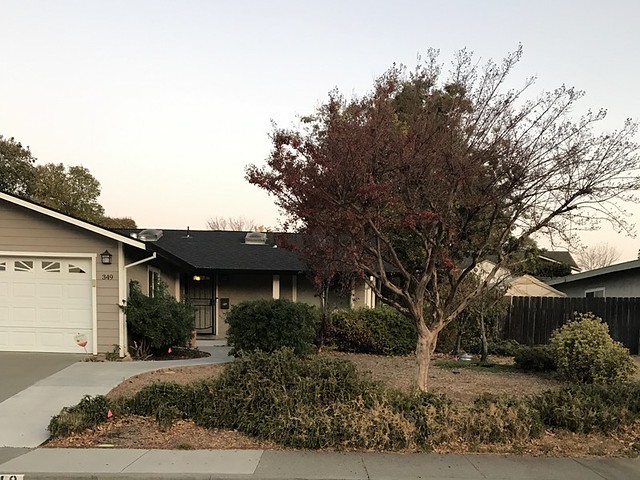Blooming Beneficial Biome

Food Forest Keeper: Kimber
I had my first garden at 10 years old. A mile from our house was an abandoned horse pasture. I made many trips with our wheelbarrow to commandeer the nutrient-rich amendment. Yes, it was a mile each way but I was seen every fall and spring making multiple trips. It was a labor of love. Over my lifetime, I have had numerous small gardens, mostly ornamental while I focused on raising my children and building a career. I needed time interacting with nature and I always longed for more. Sustainable Solano accelerated the fruition of this lifelong dream.
After my children moved out, I started volunteering on farms for fun, sense of community, and connection. After a day at Meridian Jacob sheep farm, I would come home energized, looking for what else I could do. I also started attending Fiber Shed events and tours at Be Love Farm. I attended several Sustainable Solano workshops, watched YouTube videos and online courses on permaculture. I volunteered to head my Rotary Clubs gleaning program to purchase produce with grant money from local farmers and rounding up volunteers to pick produce from backyards to donate to nonprofit agencies in Solano County.
I believe in urban food forests because they provide locally sourced, more nutrient-dense food, and abundance to share. I believe a lack of diversity in the microbiome is causing so many gut issues in Americans today. Driven by this conviction, I began my front yard remodel from decorative landscape to food by tearing out rosemary, shrubs, grasses, and had truckloads of wood chips delivered. I dug a swale and a berm. It was about this time I was selected by Sustainable Solano for their demonstration food forest makeover.
Site Details
Installation Date:
October 2020
Size:
1,570 square feet
Sun Exposure:
6-8 hours
Soil:
Clay
Number of Swales:
3
Secondary Water:
Rainwater
Roof water diverted to swales
Total annual water impact:
36,796 gallons
Design:
Designer: Derek Downey
Plant List:
Blueberry (Jubilee, Northland, Patriot), Culinary Sage, Lavender Lemon Bottlebrush, Pink Jerusalem Sage, Pineapple Guava, Purple Sage, Salvia, Tutti Frutti Butterfly Bush, Winifred Gilman Cleveland Sage
Asparagas, Artichoke, California Fuschia, Comfrey, Daylily, Gaura, Lupine, Hummingbird Sage, Salvia, Yarrow
Catmint, Okinawa Spinach, Oregano, Thyme
Egyptian Walking Onion
Thornless Blackberry (Prime Ark Freedom) and Kiwi
Installation:
I worked with Derek Downey, the permaculture designer, and Sustainable Solano’s Nicole Newell to come up with a plan and to choose the produce I most wanted to grow. We had to follow safety measures during the installation because of COVID-19. We did so by maintaining a safe distance from one another and limiting how many people could be on the project at any one time. Still we got it installed in two days. Everyone was so helpful and willing to pitch in; giving their best. We were pretty spent by the end of the second day, so Nicole called in reinforcements in the final hours.
Vision for the Future:
I asked my kids what I should name my garden. I had two in mind. One name was generic and fun, the other was riskier.
This is what my son said: “I like Blooming Beneficial Biome. I think you got this far doing what your gut and God lead you to and it’s worked. You still put in your application even though you knew it would probably be rejected, but it still worked out. I think the Blooming Beneficial Biome will elicit conversations. … I think there’s more reward in the beneficial biome, it’s the type of risk you’ve been taking this whole time.”
He is right. I did this project not only to feed myself but to also share the knowledge and produce so others will want to do the same.




